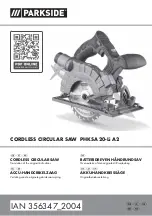
22
Figure 9-5
10.0 Operation – Metal
Consult section 8.0 for identification of the controls.
Never operate band saw without blade and wheel
covers in place and secured.
The following section contains basic information and
is not intended to cover all possible applications or
techniques using the band saw. Consult published
sources of information, acquire formal training,
and/or talk to experienced band saw users to gain
proficiency and knowledge of band saw operations.
(The following figures may or may not show your
specific band saw, but procedures are the same.)
10.1 General Procedure
1. Setup the saw to match the specific material to
be cut. “Wood Mode” for wood or “Metal Mode”
for metal.
2. Install the proper blade for use with the material
to be cut.
3. Make sure the blade and upper and lower
bearings are properly adjusted for tension and
tracking.
4. Adjust blade guide assembly so that the guide
bearings are just above workpiece (about 3/16”)
allowing minimum exposure to blade. See
Figure 9-1.
10.2 Blade break-in procedure
New blades are very sharp and therefore have a
tooth geometry that is easily damaged if a careful
break-in procedure is not followed. Consult the
blade manufacturer’s literature for break-in of
specific blades on specific materials. The following
procedure will be adequate, however, for break-in of
JET-supplied blades on lower alloy ferrous
materials.
1. Use a section of round stock.
2. Operate the saw at low speed. Start the cut with
a very light feed rate.
3. When the saw has completed about 1/3 of the
cut, increase the feed rate slightly and allow the
saw to complete the cut.
4. Keep the feed rate at the same setting and
begin a second cut on the same or similar
workpiece.
5. When the saw has completed about 1/3 of the
cut, increase the feed rate while watching the
chip formation until cutting is at its most efficient
rate (refer to “Evaluating Cutting Efficiency”
below). Allow the saw to complete the cut.
6. The blade is now considered ready for use.
10.3 Evaluating cutting efficiency
The best way to determine whether a blade is
cutting efficiently is to observe the chips formed by
the cutting.
• If chip formation is powdery, then the feed rate
is too light, or blade is dull.
• If the chips formed are curled, but colored – blue
or straw colored from heat generated during the
cut – then feed rate is excessive.
• If chips are slightly curled and not colored by
heat, then the blade is sufficiently sharp and is
cutting at its most efficient rate.
11.0 Blade Selection Guide
Proper blade selection is just as important to band
saw operation as is blade speed and material feed.
Proper blade selection will impact blade life,
straightness of cut, cut finish, and efficiency of
operation. Excessive blade breakage, stripping of
teeth, and waviness of cut are some of the results of
improper blade selection.
Using the proper blade for the job will increase the
operating efficiency of your band saw, help reduce
necessary saw maintenance, and improve your
productivity. Thus, it is important to follow certain
guidelines when selecting a saw blade.
Here are factors to consider when selecting a blade:
•
The type of material you will be cutting.
•
The thickness of the workpiece or part.
•
The features of the workpiece or part, such as
bends or curves with small radii.
These factors are important because they involve
basic concepts of saw blade design. There are five
(5) blade features that are normally changed to meet
certain kinds of sawing requirements.
They are:
• width
• pitch (number of teeth per inch)
• tooth form (or shape)
Summary of Contents for VBS-18MWEVS
Page 26: ...26 13 0 Speed and Pitch Chart Metal Table 4...
Page 27: ...27 14 0 Typical Band Saw Operations...
Page 33: ...33 18 1 1 VBS 18MWEVS MW WW Band saw Assembly Exploded View...
Page 34: ...34...
Page 39: ...39 18 2 1 VBS 18MWEVS Trunnion Support Bracket Assembly Exploded View...
Page 50: ...50 19 0 Electrical connections for VBS 18MWEVS...
Page 52: ...52 427 New Sanford Road LaVergne Tennessee 37086 Phone 800 274 6848 www jettools com...
















































